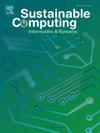Diagnostic analysis and performance optimization of scalable computing systems in the context of industry 4.0
IF 3.8
3区 计算机科学
Q1 COMPUTER SCIENCE, HARDWARE & ARCHITECTURE
引用次数: 0
Abstract
Escalating energy costs and sustainability concerns in high-performance computing (HPC) and industrial-scale systems demand advanced models for energy-efficient operations. Traditional discrete event system (DES) models, while valuable tools, often struggle with the complexities of real-world systems, particularly when dealing with simultaneous events, partial sequences, and false positives. To address these limitations, this paper introduces V-nets, a novel formalism that offers a more robust approach to modeling and analyzing complex event sequences. V-nets excel at handling concurrent events, incorporating temporal constraints, and accurately detecting partial sequences, leading to improved system diagnostics and energy efficiency. By leveraging V-nets, we can gain deeper insights into the behavior of complex systems, identify potential bottlenecks, and optimize resource allocation. This can lead to significant energy savings and improved system performance. For example, in HPC systems, V-nets can be used to monitor the energy consumption of individual components, identify idle resources, and optimize workload scheduling. In industrial settings, V-nets can help detect anomalies in production processes, leading to timely interventions and reduced downtime. The potential applications of V-nets are vast, extending beyond HPC systems to various industrial domains. As AI-driven workloads continue to grow in complexity, V-nets can play a crucial role in monitoring and optimizing energy consumption in these systems. By bridging the gap between theoretical advancements and real-world applications, V-nets have the potential to revolutionize the field of DES modeling and contribute to the development of more sustainable and efficient systems.
工业4.0背景下可扩展计算系统的诊断分析和性能优化
高性能计算(HPC)和工业规模系统中不断上升的能源成本和可持续性问题需要先进的节能操作模型。传统的离散事件系统(DES)模型虽然是有价值的工具,但经常与现实世界系统的复杂性作斗争,特别是在处理同时发生的事件、部分序列和误报时。为了解决这些限制,本文介绍了V-nets,这是一种新的形式化方法,它提供了一种更强大的方法来建模和分析复杂的事件序列。v -net擅长处理并发事件,结合时间约束,准确检测部分序列,从而提高系统诊断和能源效率。通过利用v -net,我们可以更深入地了解复杂系统的行为,识别潜在的瓶颈,并优化资源分配。这可以显著节省能源并提高系统性能。例如,在HPC系统中,v -net可用于监控单个组件的能耗,识别空闲资源,并优化工作负载调度。在工业环境中,v -net可以帮助检测生产过程中的异常情况,从而及时干预并减少停机时间。v -net的潜在应用是巨大的,从高性能计算系统扩展到各种工业领域。随着人工智能驱动的工作负载越来越复杂,v -net可以在监控和优化这些系统的能耗方面发挥至关重要的作用。通过弥合理论进步和现实应用之间的差距,v -net有可能彻底改变DES建模领域,并有助于开发更可持续和高效的系统。
本文章由计算机程序翻译,如有差异,请以英文原文为准。
求助全文
约1分钟内获得全文
求助全文
来源期刊

Sustainable Computing-Informatics & Systems
COMPUTER SCIENCE, HARDWARE & ARCHITECTUREC-COMPUTER SCIENCE, INFORMATION SYSTEMS
CiteScore
10.70
自引率
4.40%
发文量
142
期刊介绍:
Sustainable computing is a rapidly expanding research area spanning the fields of computer science and engineering, electrical engineering as well as other engineering disciplines. The aim of Sustainable Computing: Informatics and Systems (SUSCOM) is to publish the myriad research findings related to energy-aware and thermal-aware management of computing resource. Equally important is a spectrum of related research issues such as applications of computing that can have ecological and societal impacts. SUSCOM publishes original and timely research papers and survey articles in current areas of power, energy, temperature, and environment related research areas of current importance to readers. SUSCOM has an editorial board comprising prominent researchers from around the world and selects competitively evaluated peer-reviewed papers.
 求助内容:
求助内容: 应助结果提醒方式:
应助结果提醒方式:


